NOTE: These instructions relate to all Mendel kits and hot ends shipped
AFTER 20th July 2014. If you have an older kit, it is recommended you build your hot end as far as possible using this page, then switch to the old page
HERE for the wiring section.
Goal
By the end of this stage you will have finished all the mechanical construction! All that will remain is electrical wiring and commissioning. Your hot end will be fitted to your Mendel like this:
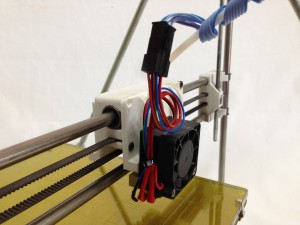
You can mount the hot end in any available slot, though our standard slot for the first extruder is front-left, as shown.
Tools
You will need the following tools:
- Sharp knife
- Pencil sharpener
- 2mm drill bit
- Small hand chuck, or slow electric drill
- Pliers or adjustable wrench
- Adjustable spanner
- 10mm spanner
- Small blowtorch or cigarette lighter
- Wire stripper
- Crimping tool
- 2.5mm Allen key
Hot end build notes
- The thermistor heatshrink is easy to confuse with the PTFE for the extruder Bowden tube, or the PTFE for the nozzle. The heatshrink is the shorter one made from thinner material.
- The heater cartridges for the Mendel/Tricolour has red leads.
- There are several stages in this construction where you have to trim pieces of PTFE. It is essential to clear any swarf created away and not to let it get into the extruder. PTFE swarf will travel to the nozzle and block it if it is allowed to contaminate the device.
- Please note, the double coil spring washers supplied with the kit often lock together during transport. Double check your spring washers are separated.
Mechanical build
The Bowden tube
The Bowden tube guides the filament from the extruder to the hot end.
| Component |
Type |
Quantity |
| 4mm diameter PTFE tube |
Hot end |
1 |
| Threaded brass union |
Hot end |
1 |
| Notched brass union |
Hot end |
1 |
|
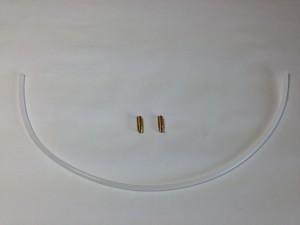 |
| Start by trimming a couple of millimetres off each end of the PTFE tube with a very sharp blade to get the ends clean and square. |
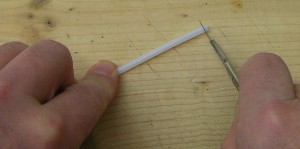 |
| Next use a pencil sharpener to cut the ends of the PTFE tube to a cone. Be very gentle. PTFE is a soft material and it is easy to remove too much. You just want a frustum of a cone at each end that doesn’t quite reach the inner hole in the tube. |
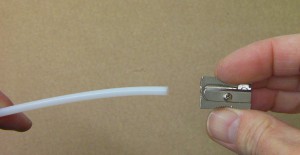 |
| Take the aluminium cooling block and screw the threaded brass union into it. This is not its final resting place, but it will give you something to grip, when you screw the brass union onto the PTFE tube thread on the union over the PTFE tube. |
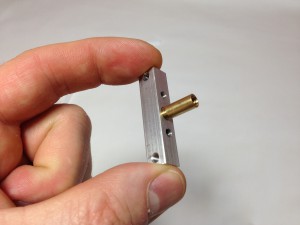 |
| To help guide the brass union onto the PTFE tube straight, put a 2mm drill into the end of the PTFE tube. This will keep the brass union and PTFE tube axially in line. You don’t want the brass screwed on at an angle. |
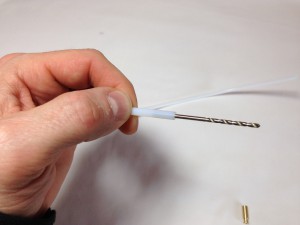 |
| Thread the drill through the brass union and aluminium cooling block. Push the brass union up to the PTFE tube, and push while turning the aluminium block clockwise. It will start to cut its own thread into the PTFE tube. |
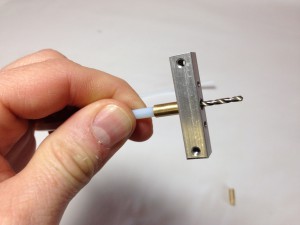 |
| After a couple of turns to get the thread started, pull out the drill, or the compression of the PTFE tube will not let you pull it out. Also, you won’t be able to screw the union on all the way; there will be too much resistance with the drill still in the tube. |
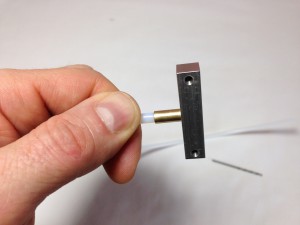 |
| Do the brass union up until it won’t turn any further. Then, unscrew the brass union. The threaded part of the PTFE tube should be about 10mm long, and it will be easier to screw each brass union on, once threaded. |
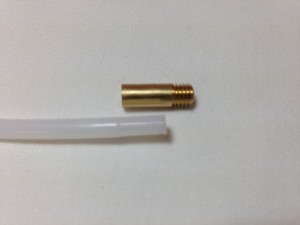 |
| Screw the slotted brass union onto the free end of the PTFE tube. Repeat the thread cutting process at the other end of the tube, this time leaving the threaded brass union on the other end of the PTFE tube. |
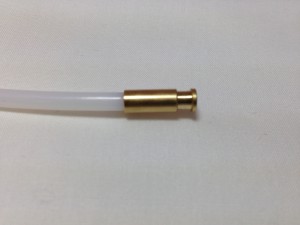 |
| Screwing the brass unions onto the PTFE tube will have compressed its inner hole. You need to open it out again so that the plastic filament that your Ormerod prints with will run freely in the tube. Use a 2mm drill bit in a small hand chuck, or slow electric drill. |
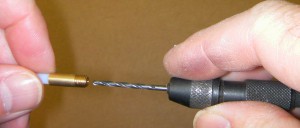 |
| Gently, and twisting clockwise all the time – never anti-clockwise, whether going in or coming out – use the drill bit to enlarge the inner hole in the PTFE where it passes through the brass. |
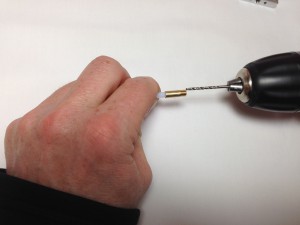 |
| Take several goes at it, going a couple of millimetres deeper each time and drawing the PTFE swarf out by keeping twisting clockwise and pulling. Stop when the tip of the drill is about 5mm past the brass union, and visible in the clear transparent PTFE. |
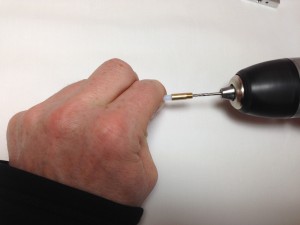 |
| The drill should pull the PTFE swarf out with it. Repeat the process at the other end of the PTFE tube. |
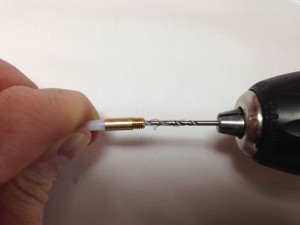 |
| Push a piece of filament through the tube, to check that it moves smoothly, with little or no friction. Push the filament into the tube from both ends. |
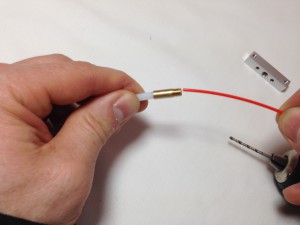 |
| The filament should push out any remaining PTFE swarf. Blow down the tube, from both ends, as well. It is very important to get any PTFE swarf out of the tube, otherwise this will end up in the nozzle the first time you try and print, blocking it! |
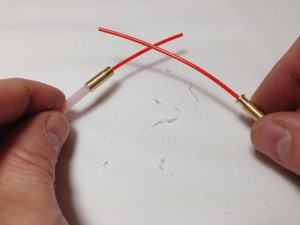 |
| The finished Bowden tube. |
 |
IMPORTANT: Push a length of printing filament through from both ends of the tube to clear out any remaining PTFE swarf; otherwise, this will end up in the nozzle the first time you try and print, blocking it!
Preparing the nozzle
The nozzle is the most important part of the printer; the molten filament is extruded out of this.
| Component |
Type |
Quantity |
| Stainless steel nozzle |
Hot end |
1 |
| 3mm diameter PTFE tube |
Hot end |
1 |
|
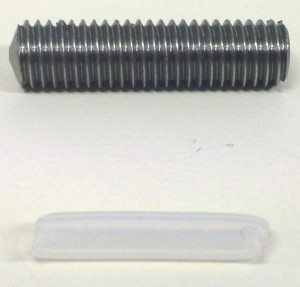 |
NOTE: All kits shipped after 1st July 2014 have the PTFE tube already cut and inserted into the stainless steel nozzle. It should look like the last picture in this section, below. Follow these instructions if you ever need to replace the PTFE tube.
| Using a sharp blade, cut one end of the PTFE liner. Try to make the cut as square to the axis of the tube as possible. Push the square-cut end of the tube into the end of the one-piece nozzle. |
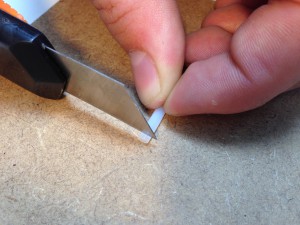 |
| Again using a sharp blade, cut the PTFE liner flush with the end of the one-piece nozzle. This should also be cut as square as possible, flush with the end of the nozzle. |
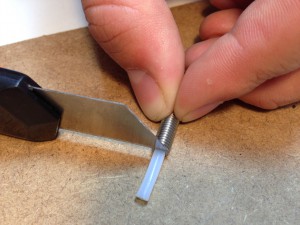 |
| If you can remove the PTFE liner tube, it should measure 8mm long, with straight cut ends. If they are cut at an angle, it creates a gap that may fill with molten plastic, and cause the nozzle to block. |
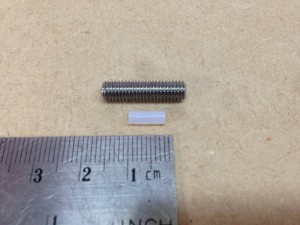 |
| The nozzle with the PTFE nozzle liner installed. |
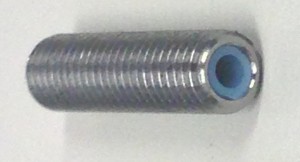 |
Assembling the Hot End metal parts
| Component |
Type |
Quantity |
| Bowden tube |
Assembled |
1 |
| Nozzle assembly |
Assembled |
1 |
| Aluminium cooling block |
Hot end |
1 |
| Aluminium heater block |
Hot end |
1 |
| Tapered brass nut |
Hot end |
1 |
|
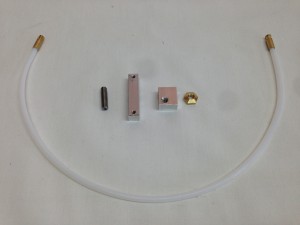 |
| Take the Bowden tube, aluminium cooling block and nozzle assembly. Screw the Bowden tube end with the threaded brass union into the aluminium cooling block, all the way on. If you leave a piece of filament in the tube, it will help align the parts of the nozzle. |
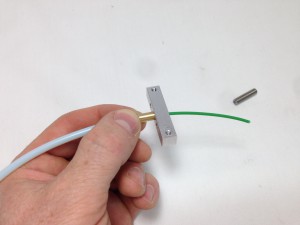 |
| Unscrew the aluminium cooling block a quarter turn from the threaded brass union. |
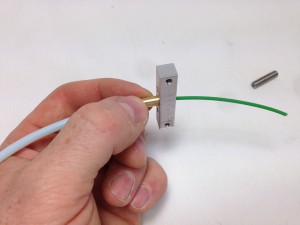 |
| While holding the brass union and cooling block in this position, screw the nozzle into the cooling block, and up tight against the brass union. Make sure the PTFE liner is still in place in the nozzle, before screwing it in. |
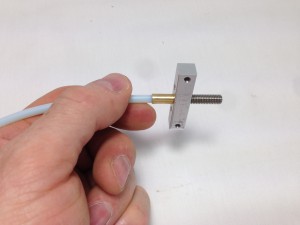 |
| Use a pair of pliers or adjustable wrench to firmly grip the brass union, close to the aluminium cooling block. You can hold the brass union between a folded piece of paper in the jaws of the pliers, to stop the jaws damaging the brass. Don’t grip too tight; the brass union is a quite thin. |
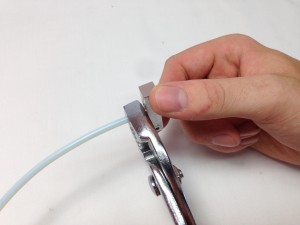 |
| Turn the aluminium cooling block clockwise to lock the whole assembly in place. Do it as tight as you can. The brass union should be locked against the top of the one piece nozzle. Remove the filament. |
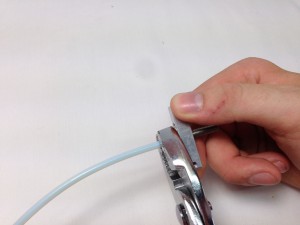 |
| Check that the brass union is close to the aluminium cooling block; no thread should be showing. Check the nozzle is not loose. The whole assembly should be rigid. You can push a piece of filament down the Bowden tube, to check it goes all the way through to the tip of the nozzle easily. |
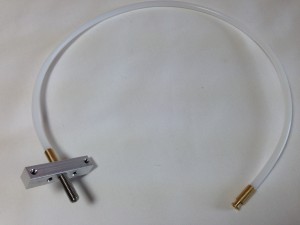 |
| Take the aluminium heater block, and screw it onto the nozzle. The small hole through the heater block should be closer to the tip of the nozzle, as shown. |
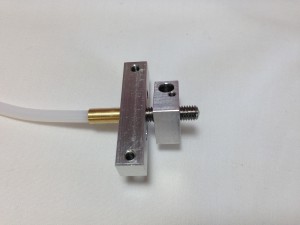 |
| Put the tapered brass nut on the nozzle. Adjust the heater block so it is square with the aluminium cooling block. Adjust the tapered brass nut, so that the cone of the nozzle continues the cone of the nut, or as close as possible. There shouldn’t be a shoulder between the two, nor should the nozzle be down inside the nut. Tighten the nut against the block with a spanner, while holding the aluminium heater block. It needs to be reasonably tight, but don’t force it so hard that you damage anything. |
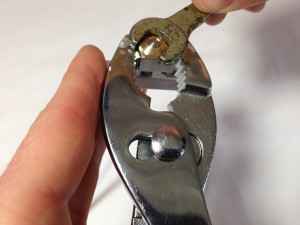 |
| The hot end with the metal parts assembled. |
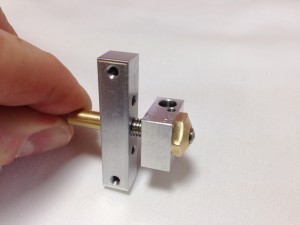 |
The cooling system
It’s very important that the top of the nozzle remains cold; if filament melts too high up, the pressure required to extrude will increase, and the nozzle will block and stop extruding.
| Component |
Type |
Quantity |
| Hot end assembly |
Assembled |
1 |
| Fan |
Hot end |
1 |
| Heatsink |
Hot end |
1 |
| Cable tie |
Hot end |
2 |
| M3x25mm cap screws |
Fastener |
2 |
|
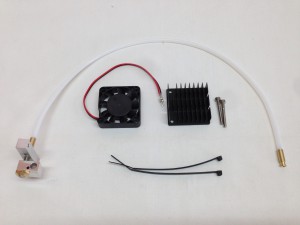 |
| Start with the heatsink. Note it has two holes in it. |
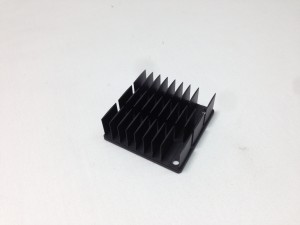 |
| Then place the fan on the fins of the heatsink, with the label facing inwards. The wires should come out to the left side. |
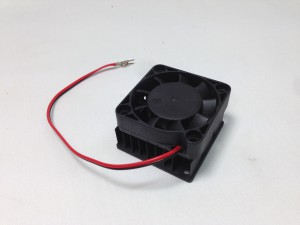 |
| Take the two M3x25mm cap screws. Feed the screws through the fan and heatsink. |
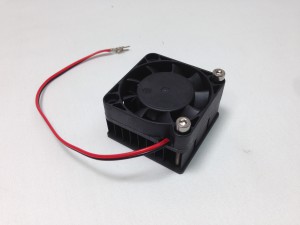 |
| Using the two screws, bolt the heatsink onto the aluminium cooling block firmly. If you have some, you can put a little heatsink compound between the cooling block and the heatsink. Make sure that the heater block is under the heatsink, not sticking out. |
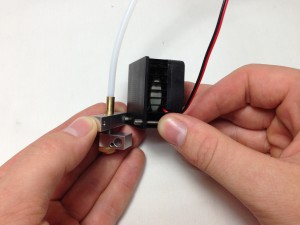 |
| The hot end assembly so far. |
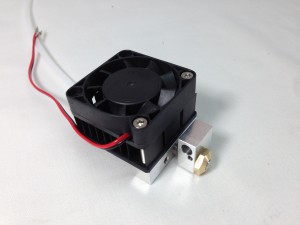 |
Hot end wiring
Thermistor preparation
| Component |
Type |
Quantity |
| Transparent PTFE heatshrink |
Hot end |
about 50mm |
| 100K thermistor |
Hot end |
1 |
|
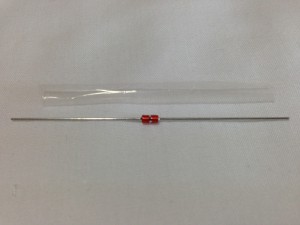 |
| Cut the transparent PTFE heatshrink about 8mm shorter than the thermistor with its axial connecting wires. Put the thermistor in it so that 4mm of wire protrudes from each end. |
 |
| Using a flame (a cigarette lighter, blowtorch, gas hob, or hot air gun work well; a hair dryer does not), shrink the heatshrink over the thermistor. Just waft the thermistor and heatshrink through the flame. You don’t want the heatshrink to overheat and burn. |
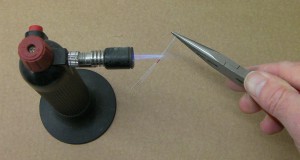 |
| If you’re doing this with a cigarette lighter, hold the thermistor at one end, and heat the heatshrink from the middle out to the other end. The heatshrink will be transparent when it has fully shrunk, and will then go back to opaque when the heat is removed. Keep it above the flame, so it doesn’t overheat and go black. |
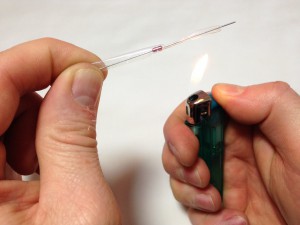 |
| Let it cool for a few moments, then turn it around and do the other side. Rolling the thermistor between your fingers while heating will improve the consistency of the heatshink. |
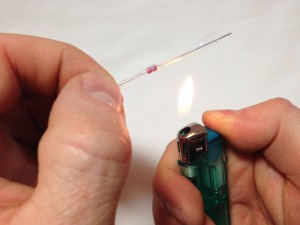 |
| Turn it around again and heat the first side, rolling it in your fingers, to get a really good, even heatshrink. Make sure it has shrunk properly around the central bulge, or it won’t fit easily into the heater block. |
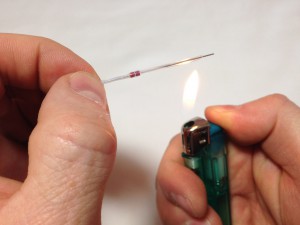 |
| This is how the thermistor should look with the PTFE shrunk onto it. |
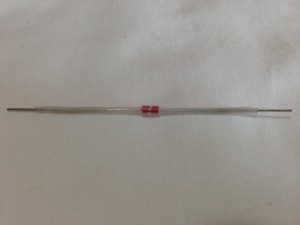 |
Heater block wiring
| Component |
Type |
Quantity |
| Hot end assembly |
Assembled |
1 |
| Thermistor assembly |
Assembled |
1 |
| Thermistor wiring – 160mm |
Hot end |
2 |
| Cartridge heater |
Hot end |
1 |
|
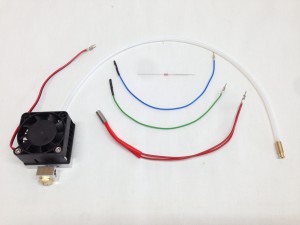 |
| Pull the thermistor through the small hole in the heater block so that it is about half way through. If you pull it with pliers, be gentle, and grip on the PTFE heatshrink, not the bare wire. If it doesn’t want to go through, try reheating the heatshrink, for a tighter fit. |
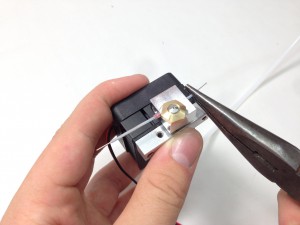 |
| To stop the thermistor falling out, turn the thermistor wire around the back of the heater block. This also means that all the wires go up one side of the hot end. |
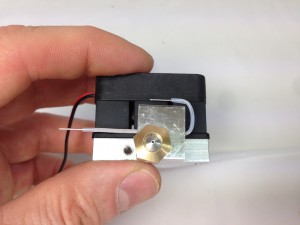 |
| Attach the thermistor wires, and push the heater cartridge into the heater block. |
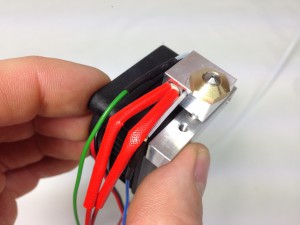 |
| Bend the wires up the side of the heatsink duct. Put a good, right hand bend in the heater cartridge wire, then secure the fan, thermistor and heater cartridge wires with two cable ties, passed through the heatsink on each side of one fin. |
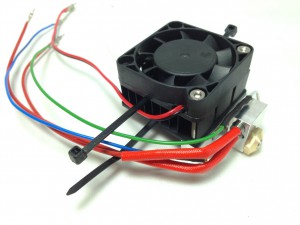 |
| Thread the cable ties into each other, then pull tight, so the wires can’t move. The bend in the heater cartridge wire will stop the heater cartridge falling out of the heater block. |
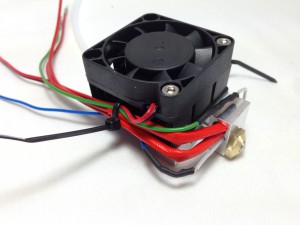 |
| The hot end viewed from the other side, showing the position of the cable ties. |
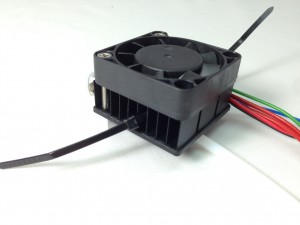 |
| Trim off the excess from the cable ties. |
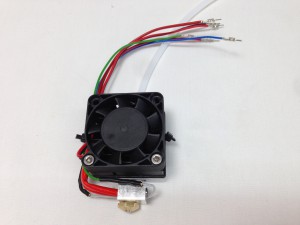 |
Wiring the hot end connector
| Component |
Type |
Quantity |
| Hot end assembly |
Assembled |
1 |
| 2×3 female black crimp housing |
Hot end |
1 |
|
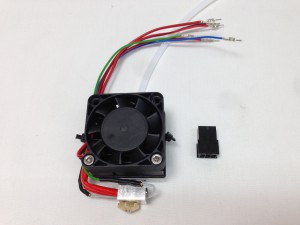 |
CAUTION! The next step describes wiring up the hot end connector. However, GREAT CARE should be taken doing this. The heater cartridge and the fan wires have 12V running through them ALL THE TIME. The thermistor wires are 3.3V, and connect directly to the Arduino chip on the Duet. If you incorrectly wire the plug, a short circuit between the thermistor wires and any of the other wires MAY DESTROY YOUR ELECTRONICS!
Wiring diagram
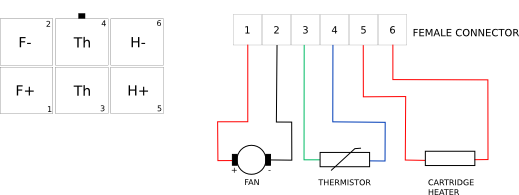
| Put the pins on the ends of the wires into the six-way female socket. The wiring diagram, above, is looking into the back of the socket, where you insert the crimps. The little black rectangle is the locking tab, and the housing has small embossed ‘1’ and ‘6’ numbers on it, so you can orientate it as the diagram. The pins are crimped on one side, and smooth on the other. The smooth sides go downwards in the diagram. Make sure the crimp is fully engaged in the housing; you can’t see the crimp easily when it is. |
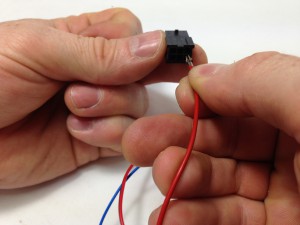 |
| The heater cartridge wires should go in the end two holes, but it doesn’t matter which way round, as the heater cartridge has no polarity. (Though the H+ and H- are the way that the machine will apply power – hence the labels.) The thermistor wires should go in the centre two holes, and again, it doesn’t matter which way around, as the thermistor has no polarity. Make sure to get the polarity of the fan right. |
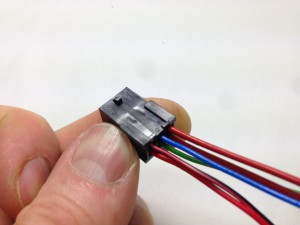 |
| Check that the pins are all the same depth into the housing. The pins are very difficult to remove without damaging them, so check twice, plug in once! They should click into place, and then shouldn’t easily push further through, or pull back out. |
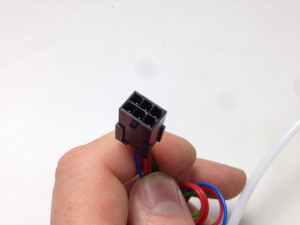 |
| We usually put a twist in the wiring, so that there is no pulling on any of the wires, as they may be different lengths. |
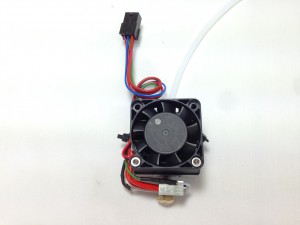 |
Ribbon cable wiring loom
The ribbon cable connects the hot end to the electronics.
| Component |
Type |
Quantity |
| 8-way ribbon cable |
Extruder |
1.2m |
| 2×3 male black crimp housing |
Extruder |
1 |
| Female crimps |
Extruder |
6 |
|
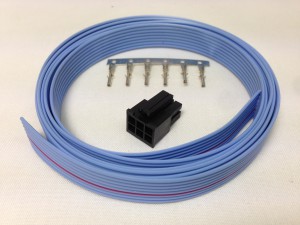 |
We supply crimps and crimp housings for the convenience of making the hot end easily detachable. If you have problems with the crimps and crimp housings, you can make the wiring connections any other way you choose; you can use different crimps, solder the connections or use ‘chocolate-block’ style screw terminals. The important thing is to wire them correctly, and to fully insulate the connections from each other.
Wiring diagram
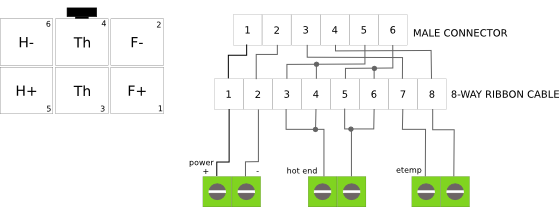
| Get the 8-way ribbon wires by stripping them off the wider ribbon cable supplied with the kit (in the ‘extruder kit’ bag). There are plenty of wires to spare. Count 8 wires in from the edge, and split it down, with your fingernail. Then it should be easy to tear down the rest of the ribbon. |
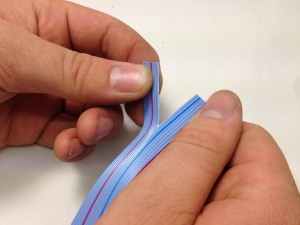 |
| Using the FEMALE crimp terminals, crimp them onto the ribbon cable wires. The 4 (four) middle wires of the ribbon cable are twisted into 2 (two) pairs to carry the required current to the hotend cartridge heater. |
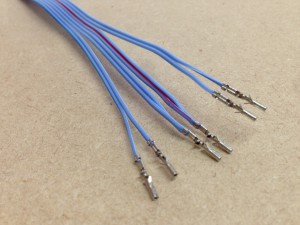 |
| Push the crimps into the MALE housing. The housing has a small embossed ‘1’ and ‘6’ number on it, so you can orientate it, as the diagram above. |
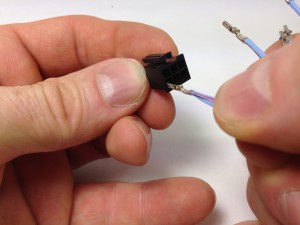 |
| With all six crimps in the housing, the crimps should be fully pushed in. |
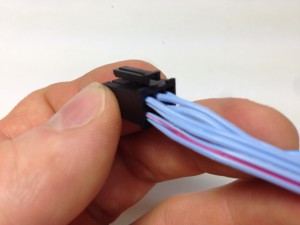 |
| Check that the crimps are all the same depth into the housing. They are very difficult to remove without damaging them, so check twice, plug in once! They should click into place, and then shouldn’t easily push further through, or pull back out. |
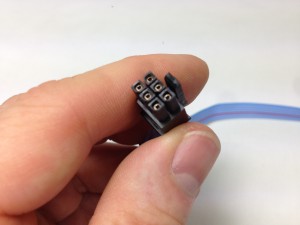 |
| At the other end of the ribbon cable, split the wires, and tin them with a soldering iron. Again, the outer two pairs are for the thermistor and the fan; the four middle wires are split into pairs, and soldered together, for the hot end heater cartridge. |
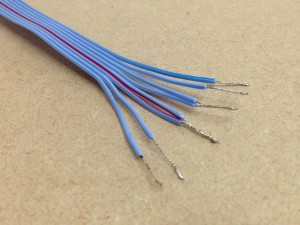 |
| Plug the ribbon cable wiring loom into the hot end, checking that the doubled-up ribbon wires go to the hot end thermistor wires. Use a multimeter to check the resistance of the heater cartridge and the thermistor by measuring from the far ends of the wires. The Mendel heater cartridge should be around 3.4 ohms. The thermistor should be about 100K ohms at 25C (ie room temperature), and more if it is colder than this. Also check that the resistance between the wires and the aluminium block is infinite and that nothing is shorting out. |
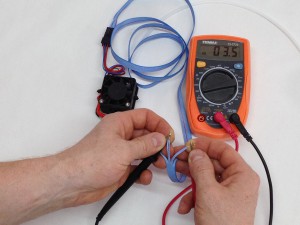 |
Final assembly and mounting
Nozzle mounting screws
| Component |
Type |
Quantity |
| Hot end assembly |
Assembled |
1 |
| Double coil spring washers |
Hot end |
2 |
| M3x16mm cap head screws |
Hot end |
2 |
| M3 Washer (optional, not shown) |
Fastener |
2 |
|
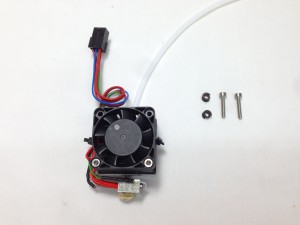 |
| The last components to fit are the double coil spring washers. Attach them as shown using two M3x16mm cap head screws. You can put an M3 washer above each double coil spring washer, if you wish. |
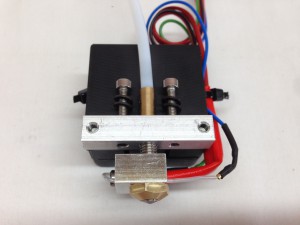 |
Nozzle mounting brackets
If you haven’t already done so for another hot end, you now need to fit the nozzle mounting brackets:
| Component |
Type |
Quantity |
| Nozzle Mount Front |
Printed part |
1 |
| Nozzle Mount Rear |
Printed part |
1 |
| M3x25mm Cap Screw |
Fastener |
4 |
| M3 Nuts |
Fastener |
4 |
|
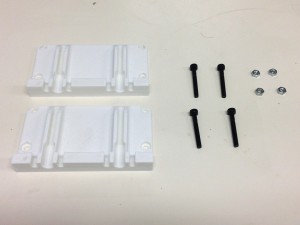 |
| You’ll notice the nozzle mounts are slightly different. The front mount has circular holes for housing the head of the cap screw, the rear mount has a hexagonal hole for the M3 nuts. The mounts are otherwise identical, so it doesn’t really matter which way around you put the mounts on. Insert the cap screws through the holes in the front nozzle mount, through the holes in the x-carriage and secure using an M3 nut in the rear nozzle mount. |
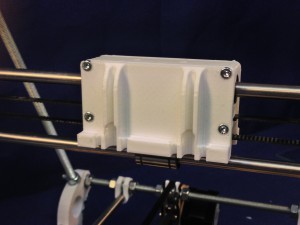 |
Mounting the hot end
Generally, you can fit the hot end in any of the available slots; you set the final position of the nozzle on the corner of the bed using the M206 gcode (instructions in ‘Printing’). If you’re building a Tricolour, our standard layout is to fit the first extruder on the front left space.
| Use the M3x16mm cap screws in the aluminium cooling block to attach the hot end to the X carriage of your Mendel. The PTFE tube clips into the printed vertical channel in the X carriage. The springs should fit underneath the lip of the x carriage. Therefore the order, top to bottom, is cap screw, x carriage, (optional M3 washer), spring, heatsink block. |
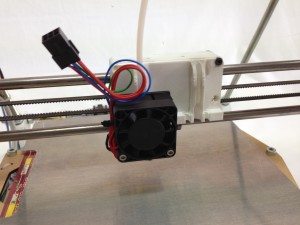 |
| This picture is from a Mono Mendel with the fan and heatsink removed to show how the hot end is mounted; you DO NOT need to remove yours. It also shows the optional washers above the springs, if the springs don’t sit quite flat. Make sure your hot end heater cartridge is fully inserted into the heater block, NOT like the picture! |
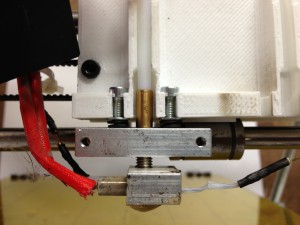 |
| Put the free end of the PTFE tube in the extruder drive – the tube should run outside the machine, not between the threaded rods. The extruder drive can be put in a number of different places; see the ‘Improvements’ page of the instructions. (Ignore the extra wiring in this picture, it is added at the ‘Wiring’ stage.) |
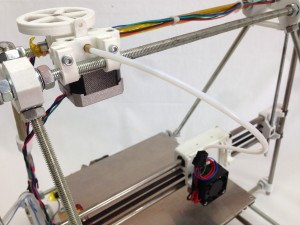 |
| Secure the Bowden tube in the extruder drive block with the printed tongue, placing it in the available slot. |
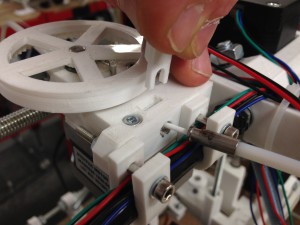 |
| The thin end of the tongue goes towards the outside, locking the slotted brass union in place. |
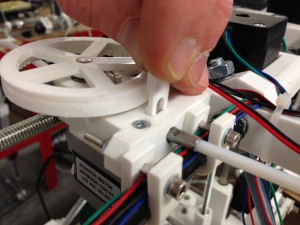 |
| The pictures show filament in the drive and tube already; the tube can be fitted and released with or without filament in it. |
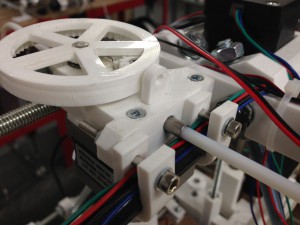 |
| We usually connect and wrap the hot end wiring around the Bowden tube, to keep it neat. Twist the ribbon cable loosely round the PTFE tube to the top. Wrap it 10 turns or so. Do not pull it tight. |
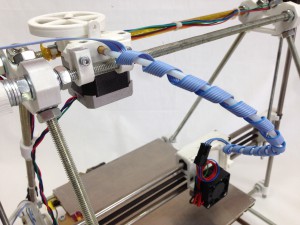 |
| By hand, run the X carriage back and forth along the X-axis, to the end of its travel, and check that it runs freely and smoothly. Check that the wiring does not catch on anything. Attach the glass plate to the bed with the four clips. |
 |
Tricolour Mendel
Build just one hot end at the moment; any mistake in construction will not be repeated when you build the others! Mount the hot end in the front-left mounting point on the X carriage; this is our standard position.
The Tricolour Mendel needs three hot ends in total. However, we recommend you finish the Mono build instructions, commission your printer and get some experience using it as a Mono, before moving on to the Tricolour build instructions.














































































